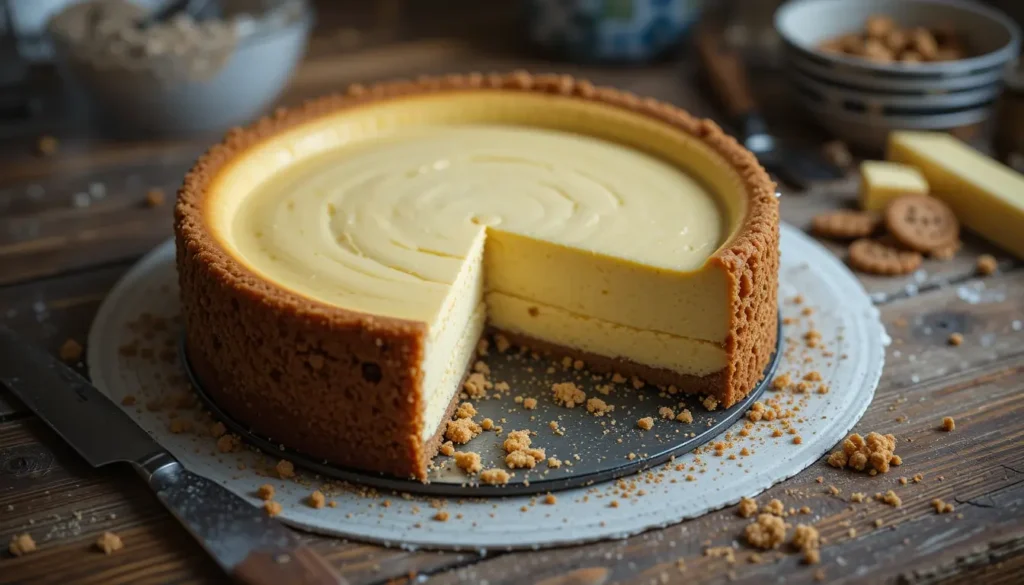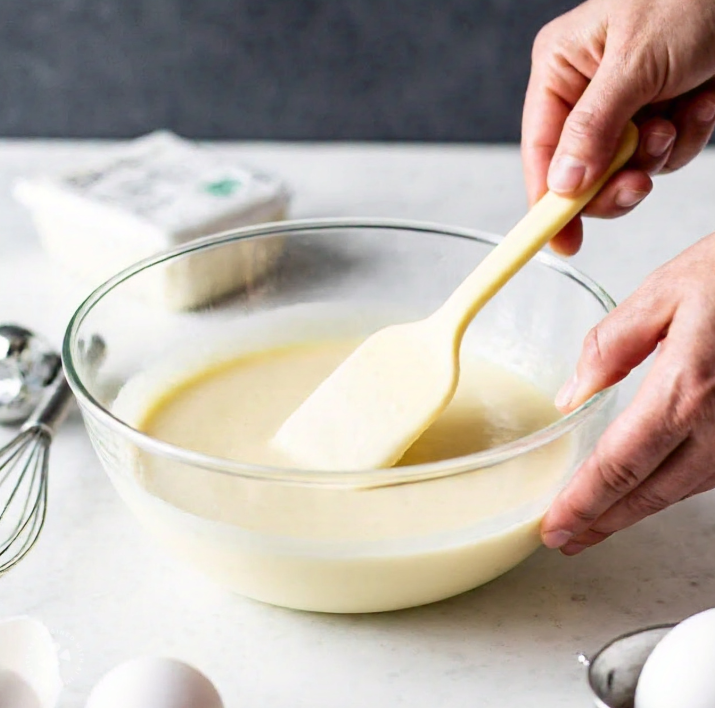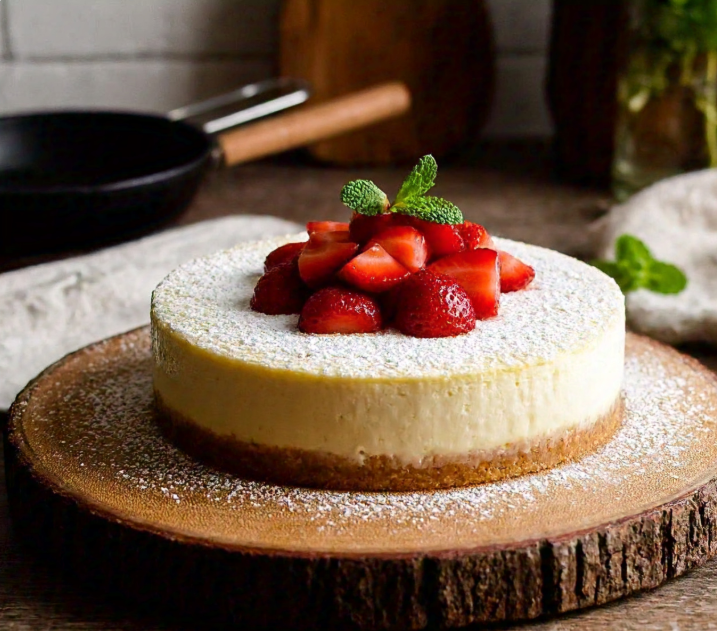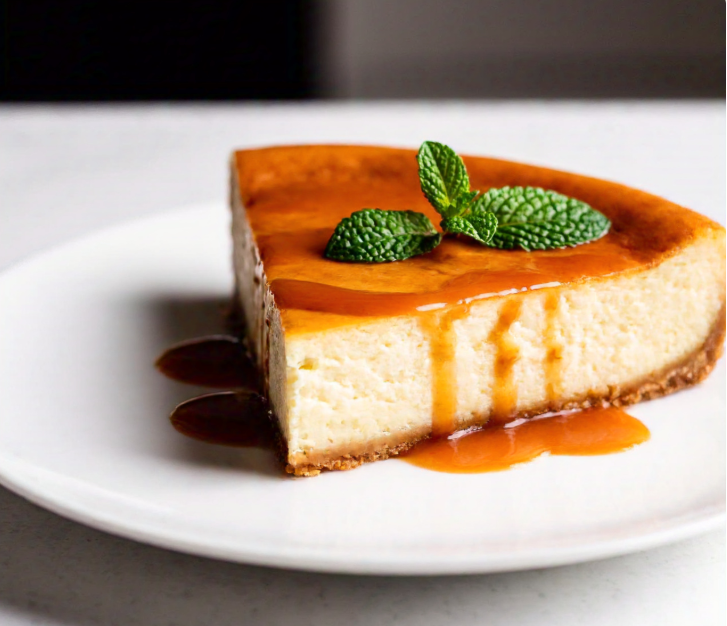Cheesecake lovers know that this classic dessert holds a special place on the menu. It’s creamy, decadent, and versatile, pleasing the taste buds of both casual fans and die-hard dessert enthusiasts. But what happens if you don’t put flour in cheesecake? Does it still hold its form? Does the texture suffer? Can you make a successful cheesecake without flour? These are questions that many home bakers ask, especially when trying to adapt recipes for dietary preferences or by accidently leaving out an ingredient.
Table of Contents
Understanding the Role of Flour in Cheesecake
First things first—what is the role of flour in a cheesecake? When considering what happens if you don’t put flour in cheesecake, it’s important to understand its function. Cheesecake is typically made with a mixture of cream cheese, eggs, sugar, and a crust (usually made of graham crackers or cookies). These ingredients are combined to form a silky, dense texture.
Flour, when used in cheesecake recipes, serves as a stabilizer. It binds the batter together, helping the cheesecake maintain its shape during baking and cooling. Without flour, the mixture relies heavily on the eggs to set correctly. But does that mean you need flour to succeed? Not exactly.
Some cheesecakes skip flour altogether, like the popular New York-style cheesecakes, which lean on eggs and cream cheese alone. Others use flour for extra firmness and a cake-like quality. So, leaving it out doesn’t ruin your cheesecake—but it does change the texture.
Common Ingredients in Cheesecake and Their Purposes
Before exploring what happens when you leave flour out, let’s look at the key ingredients in cheesecake and what they do:
Why Flour is Sometimes Added to Cheesecake Batter
- Stabilizing the Batter: Flour works as a binder. It prevents the cheesecake from being too runny and helps it firm up as it bakes.
- Texture Control: Adding flour gives cheesecake a slightly denser, cake-like texture. It’s great if you want the dessert to feel more solid and less creamy.
- Preventing Cracks: Flour can reduce the chance of cracks by absorbing moisture. This helps prevent rapid cooling from damaging the surface of the cheesecake.
However, not all cheesecakes need flour. In fact, many recipes purposefully leave it out to prioritize a creamier, silkier consistency.
Cheesecake Texture Without Flour: What to Expect?

When you leave flour out of the cheesecake batter, you’ll notice a few changes:
- Creamier Texture: Flourless cheesecakes are smoother and richer. They melt in your mouth without the slight “bite” you’d get from flour-based cheesecakes.
- Softer Set: A cheesecake without flour might not be as firm. It depends more on the eggs to set during baking, so it might feel slightly wobbly until fully chilled.
- Increased Risk of Cracks: Without flour’s stabilizing properties, there’s a higher chance of cracks forming as the cheesecake cools.
Despite these differences, leaving out flour doesn’t spell disaster. With a little finesse, you can still achieve an excellent cheesecake that rivals any traditional recipe.
What Happens to the Structure of Cheesecake Without Flour?
When baking a cheesecake without flour, the overall structure relies on a delicate balance of ingredients. Let’s dive into the science behind it.
Does Omitting Flour Impact the Creaminess?
Yes, and in a good way! Flour can slightly reduce creaminess because it absorbs moisture. Without flour, the cheesecake retains its silky-smooth texture. That’s why flourless cheesecakes are so popular for their luxurious mouthfeel.
If you’re aiming for a more custard-like cheesecake, leaving out the flour is a great option. You get a dessert that feels light, indulgent, and incredibly smooth.
Can a Cheesecake Set Properly Without Flour?
The short answer: Yes, it can! Cheesecakes depend on eggs to set rather than flour. When baked correctly, the eggs coagulate (firm up) and help the cheesecake hold its form.
However, achieving the perfect set without flour requires careful baking techniques:
- Bake at a low temperature to avoid curdling the eggs.
- Avoid overmixing the batter, which can introduce too much air.
- Use a water bath to create gentle, even heat throughout the baking process.
With these methods, a flourless cheesecake can set beautifully and hold its shape just as well as a flour-based one.
Flourless cheesecakes often rely on a sturdy crust to provide structure. If you’re unsure about the best options for your crust, you might find this guide helpful: what is the best biscuit to use for cheesecake base.
Common Problems When You Don’t Use Flour in Cheesecake
Let’s be honest—leaving out flour can sometimes lead to a few challenges. But don’t worry, there’s a fix for each problem.
Cheesecake Cracking Without Flour
Cracks are one of the most common issues when baking a flourless cheesecake. Flour helps absorb excess moisture, preventing cracks as the cake cools. Without it, cracks can form due to rapid temperature changes.
Solutions:
- Always bake the cheesecake in a water bath. The steam keeps the environment moist and prevents cracks.
- Cool the cheesecake gradually. Turn off the oven and let it sit inside for 30 minutes before removing it.
Runny or Undercooked Cheesecake Batter
Since flour adds some stability to the batter, leaving it out can cause the cheesecake to remain runny or not set properly.
Solutions:
- Ensure the cheesecake is baked long enough. The edges should be set, and the center should jiggle slightly like gelatin.
- Use high-quality eggs and cream cheese. These ingredients are the stars of a flourless cheesecake and will help it hold together.
Difficulty in Slicing and Serving the Cheesecake
A flourless cheesecake is softer and creamier, which can make slicing tricky.
Solutions:
- Chill the cheesecake for at least 4-6 hours (or overnight) to firm it up completely.
- Use a sharp knife dipped in hot water to make clean slices.
By following these simple fixes, you can overcome any problem caused by leaving out flour and still enjoy a flawless dessert.
Flour Alternatives for Cheesecake Recipes
Now that we know what happens when you don’t put flour in cheesecake, the next logical step is exploring alternatives. Whether you’re baking for dietary reasons or simply trying to troubleshoot a recipe, there are several substitutes that work beautifully without compromising texture or flavor.
Using Cornstarch as a Substitute for Flour
Cornstarch is one of the most popular flour alternatives in cheesecake recipes. It serves as an excellent thickener and stabilizer.
Why It Works:
- Cornstarch absorbs moisture and helps the cheesecake set properly.
- It’s lighter than flour, so it doesn’t weigh down the batter.
- It’s gluten-free, making it perfect for those with gluten sensitivities.
How to Use It:
For every tablespoon of flour, substitute with ½ tablespoon of cornstarch. Add it gradually to your batter to prevent clumping.
Gelatin for Stability in Flourless Cheesecakes
If you want a cheesecake with a firmer texture but no flour, gelatin can be a game-changer.
Why It Works:
- Gelatin helps the cheesecake set without baking, which is especially useful for no-bake recipes.
- It gives a clean, smooth finish while keeping the batter firm.
How to Use It:
Dissolve gelatin powder in warm water and mix it into the cheesecake batter before chilling. About 1 teaspoon of gelatin is sufficient for a standard 9-inch cheesecake.
Almond or Coconut Flour for Gluten-Free Options
If you’re craving a cheesecake with a little structure but without traditional flour, almond or coconut flour can save the day.
Why It Works:
- Almond flour adds a nutty flavor that pairs wonderfully with creamy cheesecake.
- Coconut flour is absorbent, making it a great stabilizer for the batter.
How to Use It:
Use almond or coconut flour in smaller quantities than regular flour. For instance, 1 tablespoon of almond flour can replace 2 tablespoons of regular flour.
These alternatives ensure that you don’t have to compromise on the quality of your cheesecake while catering to various dietary needs. Plus, they add unique flavors that can elevate your dessert.
How to Make a Perfect Flourless Cheesecake
Now that you understand the science and potential challenges, let’s put it all together with a step-by-step guide to making the perfect flourless cheesecake.
Step-by-Step Recipe for Flourless Cheesecake
Here’s a foolproof recipe that’s simple yet indulgent:
Ingredients:
- 2 cups cream cheese (softened)
- 1 cup granulated sugar
- 3 large eggs
- 1 teaspoon vanilla extract
- 1 cup sour cream
- 1 tablespoon cornstarch (optional for extra stability)
Instructions:

- Prepare the Crust: Use crushed graham crackers or almond flour mixed with melted butter. Press it firmly into a greased springform pan. Chill the crust while preparing the filling.
- Mix the Batter: In a large bowl, beat the cream cheese until smooth. Gradually add sugar and beat until fully incorporated.
- Add Eggs and Flavor: Add the eggs one at a time, mixing on low speed to avoid overbeating. Stir in vanilla extract and sour cream for added creaminess.
- Optional Thickener: If desired, add a tablespoon of cornstarch and mix gently. This will help stabilize the cheesecake.
- Bake in a Water Bath: Pour the batter into the prepared crust. Place the pan in a larger baking dish filled with 1 inch of hot water. Bake at 325°F (160°C) for 60-70 minutes.
- Cool Gradually: Turn off the oven and allow the cheesecake to cool with the door slightly open for about 30 minutes. This reduces the risk of cracks.
- Chill Overnight: Transfer the cheesecake to the fridge and chill for at least 4 hours (overnight is best).
Tips to Avoid Common Flourless Cheesecake Mistakes
- Don’t Overmix: Overmixing introduces air bubbles that can cause cracks. Use low speed and mix just until smooth.
- Use a Water Bath: This ensures even baking and prevents the edges from cooking faster than the center.
- Check for Doneness: A perfectly baked cheesecake will have slightly firm edges and a center that jiggles like gelatin.
- Avoid Rushing the Cooling Process: Let the cheesecake cool gradually to prevent cracks. Sudden temperature changes are a no-go.
This step-by-step process guarantees a smooth, creamy, and beautifully set cheesecake—no flour required!
Benefits of Leaving Flour Out of Cheesecake
Believe it or not, leaving flour out of cheesecake isn’t just about necessity—it comes with its own set of benefits that make your dessert even better.
Is Flour Necessary for a Gluten-Free Cheesecake?
Nope! Leaving out flour allows you to create a gluten-free cheesecake without any fancy tricks. It’s ideal for serving guests with dietary restrictions while still delivering all the creamy goodness of a cheesecake without flour.
- Alternative Crust Options: Use almond flour, gluten-free cookies, or crushed nuts for a completely gluten-free base.
- Flour-Free Filling: Without flour, the filling stays naturally smooth and indulgent.
How Flourless Cheesecake Improves Texture and Flavor
When you skip the flour, you eliminate any possibility of graininess in the batter. Instead, the cheesecake achieves a silky, luxurious texture that’s hard to resist.
- More Creaminess: The absence of flour allows the eggs and cream cheese to shine. The result is a melt-in-your-mouth experience.
- Enhanced Flavor: Without flour acting as a filler, the flavors of the cream cheese, vanilla, and any additional ingredients (like chocolate or fruit) become more pronounced.
So, leaving out the flour isn’t a setback—it’s an upgrade in many ways!
Does Leaving Out Flour Affect Baking Time?
Baking a flourless cheesecake requires a bit of finesse with timing. Flour helps absorb moisture, so without it, the batter can take longer to set.
How to Adjust Cooking Time Without Flour
- Lower the Temperature: Bake at a slightly lower temperature (around 325°F or 160°C) to ensure the cheesecake cooks evenly without browning too quickly.
- Add Extra Time: Flourless cheesecakes might need an extra 10-15 minutes in the oven, depending on the recipe. Keep an eye on the center—it should jiggle slightly but not look liquidy.
Signs That a Flourless Cheesecake is Fully Cooked
Not sure if your cheesecake is done? Look for these signs:
- The edges are firm and slightly pulled away from the pan.
- The center jiggles gently when you shake the pan.
- There’s no visible wet batter or sinking spots in the middle.
Remember: It’s better to slightly underbake a cheesecake than to overbake it. Overbaking can cause the texture to turn dry and crumbly, even without flour.
Expert Solutions to Fix Cheesecake Without Flour Problems
Baking a flourless cheesecake might sound daunting, but even if things don’t go perfectly, there are always ways to fix it. Let’s address common issues and expert solutions to help you perfect your dessert when you’re wondering what happens if you don’t put flour in cheesecake.
How to Fix a Cracked Flourless Cheesecake
A cracked cheesecake is one of the most common complaints when baking without flour. The lack of stabilizers like flour can make the surface more prone to cracks, but don’t worry—it’s fixable.
Quick Fixes:
- Cover with Toppings: Cracks can be easily disguised with a layer of whipped cream, fruit compote, chocolate ganache, or caramel sauce. Not only does this hide imperfections, but it also enhances the flavor.
- Smooth It Out: Use a warm spatula to gently smooth over small cracks while the cheesecake is still slightly warm. This won’t work for major cracks but can help minor ones.
Preventive Measures:
- Always bake the cheesecake in a water bath to create a moist baking environment.
- Let the cheesecake cool gradually by leaving the oven door slightly open after baking.
Ensuring Proper Firmness Without Flour
If your cheesecake comes out too soft or runny, the batter likely didn’t set properly during baking. Without flour to stabilize the mixture, achieving firmness can be a little trickier.
Solutions:
- Chill Longer: A flourless cheesecake can firm up significantly with extra chilling time. Let it rest in the refrigerator overnight for the best results.
- Rebake the Cheesecake: If the cheesecake is too runny after cooling, place it back in the oven at a low temperature (300°F or 150°C) for 10-15 minutes. Keep an eye on the consistency—it should gently jiggle in the center.
- Add Stabilizers Next Time: Use alternatives like cornstarch or gelatin to help the batter set more effectively.
Preventing Sinking or Uneven Baking
Cheesecakes without flour can sometimes sink in the center due to uneven baking or overmixing the batter.
Solutions:
- Don’t Overmix: Overmixing incorporates too much air, causing the cheesecake to rise and fall unevenly. Mix the batter just until the ingredients are combined.
- Bake Evenly: Use a water bath to ensure gentle, even heat around the cheesecake. This prevents sinking and keeps the texture uniform.
- Test for Doneness: Insert a clean knife or toothpick near the center. It should come out with a small amount of moist crumbs but no liquid batter.
By addressing these common problems, you can master the art of baking flourless cheesecakes and enjoy consistent results every time.

Frequently Asked Question
What happens if you don’t put flour in cheesecake?
Leaving out flour makes the cheesecake creamier and silkier but slightly softer in texture. The cheesecake will still set properly if baked correctly, but you might notice a higher chance of cracks and a more delicate structure.
Can I use cornstarch instead of flour in cheesecake?
Yes! Cornstarch works as a great substitute for flour in cheesecake. Use about half the amount of cornstarch compared to flour for stabilization without affecting the texture.
Is flour necessary for cheesecake?
No, flour is not essential for cheesecake. Many traditional cheesecakes, like New York-style cheesecakes, don’t include flour. The eggs in the batter provide enough stability when baked correctly.
How do I fix a runny cheesecake without flour?
If the cheesecake is too runny, chill it longer in the refrigerator to allow it to firm up. If it’s still not set, rebake it at a low temperature for 10-15 minutes, checking frequently for doneness.
Why did my cheesecake crack without flour?
Cracks often occur because of rapid cooling or a lack of moisture during baking. Use a water bath, cool the cheesecake gradually, and avoid overbaking to minimize cracks.
What’s the best flour alternative for cheesecake?
Cornstarch, gelatin, or almond flour are excellent flour alternatives. Each provides stability while keeping the texture smooth and delicious.
Final Thoughts on Cheesecake Without Flour
To flour or not to flour—that’s the cheesecake question. What happens if you don’t put flour in cheesecake? Flour isn’t essential for a delicious dessert; its absence creates a creamier, more luxurious texture. Flourless cheesecakes highlight the pure flavors of cream cheese, eggs, and sugar, though they may require a bit more care.
Whether you’re baking for gluten-free guests or prefer a silkier texture, flourless cheesecakes are a fantastic option. With the right techniques and patience, they can be as impressive as any traditional recipe.
Discover Thickening Agent in Cheesecake in this article.

